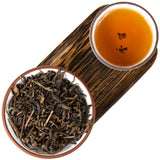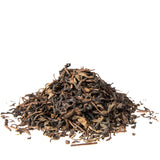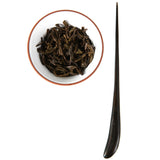In the quiet of the temple's bamboo garden, a young disciple approached Lao Cha, sitting in the shade of an old, twisting pine. "Sifu," he asked, holding out a handful of Huang Da Cha leaves, "what secrets do these hold?"
– "Imagine a farmer, hands as rugged as mountain paths, crafting a brew as mellow as a lullaby. This tea," – he said, holding up the golden liquor, – "is like his work: earthy hands yielding a harvest as sweet and comforting as bread fresh from the oven. It's simple yet profound, unassuming yet rich – a true lesson in contrasts. Remember - the finest warmth often comes from the coarsest hands."
The disciple smiled, closed his eyes, and took a sip, understanding dawning at him with the flavor on his tongue.
Huang Da Cha is a nice and comforting tea. It comes from Anhui – region with a millennium-old history of tea production and one of the cradles of China's vast tea culture. Anhui is home to some of China's most renowned teas, and Yellow Tea is a signature product of the region.
This Huang Da Cha grows in a mountainous tea garden more than 800m above sea level. The large leaves for this tea come from tea bushes aged 60+ years. Its picking standard is one bud with two or three tightly twisted, glossy leaves mixed with stems and stalks.
Yellow tea's processing involves the well-known steps of withering, pan-roasting, and drying, plus an additional step, unique to Yellow Teas – Men Huang (闷黄) – "stewing". During that stage, the tea master "stews" the leaves using bamboo baskets or wrapping them in linen or paper and putting them into a controlled hot environment for a relatively short period of time. Under the heat, the residual moisture in the leaves triggers a transformation, which alters the taste, making it softer and mellower, and results in the characteristic yellow color of the tea leaves. The "yellowing" phase is also at the core of the formation of yellow tea's distinctive mellow and sweet taste and aroma.
Our Huang Da Cha opens up with a sweet, roasted "coffee" scent, well-known to those familiar with Japanese Hojicha. Over the brews, the golden yellow tea liquor transforms further, adding a sweet, fruity accent that develops into a rich and comforting milky cacao taste. As the tea maintains a smooth profile without any trace of bitterness or astringency, each sip offers the soothing warmth of roasted flavors. As the steeps progress, the air fills with the homely scent of freshly baked bread crust. If every tea tells a story, this one would be of the rugged, coarse hands of the farmer who gives birth to the softness and sweetness of the freshly baked golden-crusted bread.
The tea leaves a pleasantly sweet aftertaste with a soft and mellow character. It is further enriched by the deep, gratifying aroma of baked grains and bread crust. The leaves, after the brew, present themselves in a glossy, dark ochre to brownish hue, with dark brown stalks, uniform and without impurities.
Along with its mellow and sweet taste, our Huang Da Cha is good news for caffeine-sensitive tea drinkers. It's naturally lower in caffeine due to the high content of stems and stalks, and the usage of bigger, grown-up leaves that contain less of this stimulating substance compared to buds and younger, more tender leaves.
Watch a short video about Yellow Tea
- Place of Origin: Guihua Village, Jinzhai County, Anhui Province, China
- Altitude: 800m
- Harvest Date: May 2025
- Picking Standard: One bud with two or three leaves, stems and stalks
- Aroma: Roasted, cacao with milk
- Taste: Sweet, cacao with fruity notes.
- Cultivar: Local Quinti Zhong (当地群体种)
- Caffeine Level: low
Brewing guidelines:
 1g per 70-100ml
1g per 70-100ml ![]() 3-4min
3-4min
 1g per 20ml
1g per 20ml ![]() 5sec + 5sec for each subsequent infusion
5sec + 5sec for each subsequent infusion





